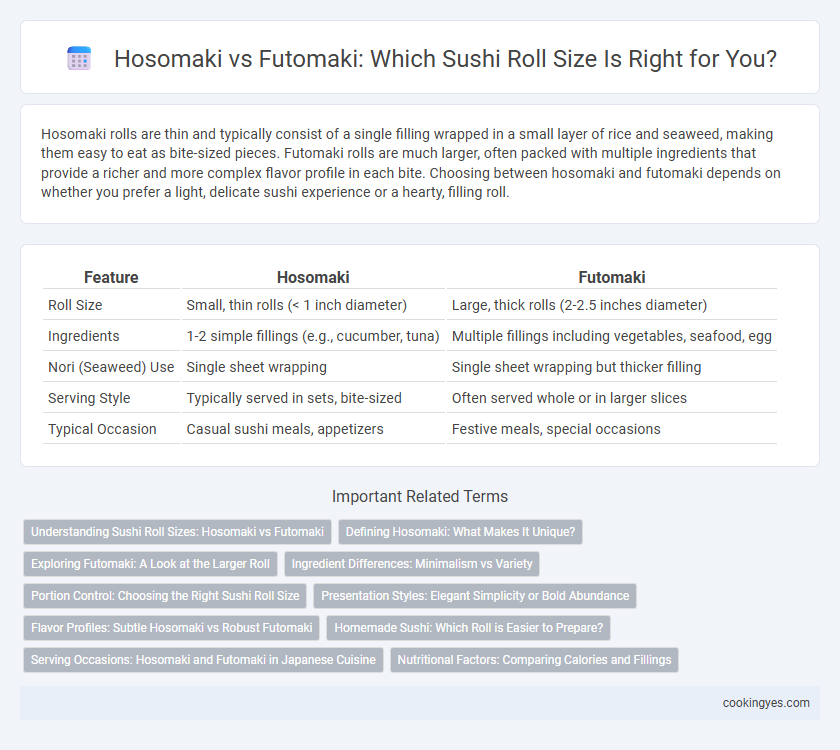Hosomaki rolls are thin and typically consist of a single filling wrapped in a small layer of rice and seaweed, making them easy to eat as bite-sized pieces. Futomaki rolls are much larger, often packed with multiple ingredients that provide a richer and more complex flavor profile in each bite. Choosing between hosomaki and futomaki depends on whether you prefer a light, delicate sushi experience or a hearty, filling roll.
Table of Comparison
| Feature | Hosomaki | Futomaki |
|---|---|---|
| Roll Size | Small, thin rolls (< 1 inch diameter) | Large, thick rolls (2-2.5 inches diameter) |
| Ingredients | 1-2 simple fillings (e.g., cucumber, tuna) | Multiple fillings including vegetables, seafood, egg |
| Nori (Seaweed) Use | Single sheet wrapping | Single sheet wrapping but thicker filling |
| Serving Style | Typically served in sets, bite-sized | Often served whole or in larger slices |
| Typical Occasion | Casual sushi meals, appetizers | Festive meals, special occasions |
Understanding Sushi Roll Sizes: Hosomaki vs Futomaki
Hosomaki sushi rolls are thin, typically consisting of one or two ingredients wrapped in a small sheet of nori and rice, making them about 1 inch in diameter and perfect for delicate flavors. Futomaki rolls are much thicker, often 2 to 2.5 inches wide, containing multiple ingredients like vegetables, seafood, and tamago, offering a richer, more complex taste experience. Choosing between hosomaki and futomaki depends on appetite and ingredient preference, with hosomaki offering simplicity and futomaki delivering variety and fullness in each bite.
Defining Hosomaki: What Makes It Unique?
Hosomaki is defined by its thin, delicate roll size, typically containing one or two ingredients, wrapped tightly in nori and sushi rice, making it distinctively smaller and simpler than futomaki. This minimalist approach emphasizes the flavor and texture of individual fillings, such as cucumber, tuna, or avocado, highlighting purity and precision in sushi craftsmanship. The smaller diameter of hosomaki, usually about 1 inch, contrasts with the larger, more complex futomaki rolls that combine multiple ingredients in a thicker presentation.
Exploring Futomaki: A Look at the Larger Roll
Futomaki sushi rolls are significantly larger and thicker than Hosomaki, typically measuring around 2 inches in diameter, allowing for a more complex combination of ingredients such as tamago, cucumber, and kanpyo. This size difference provides a richer texture and flavor profile, making Futomaki a popular choice for those seeking a more substantial sushi experience. In contrast, Hosomaki rolls are smaller, about 1 inch in diameter, often containing a single ingredient like tuna or cucumber for a simpler, bite-sized option.
Ingredient Differences: Minimalism vs Variety
Hosomaki features thin rolls with a minimalist approach, typically containing one or two ingredients such as cucumber, tuna, or avocado, wrapped in a small amount of rice and seaweed. Futomaki offers a larger roll size packed with a variety of ingredients like tamago, kanpyo, pickled vegetables, and cooked seafood, creating a complex flavor profile. The size difference directly influences ingredient complexity, with hosomaki emphasizing simplicity and futomaki showcasing diversity.
Portion Control: Choosing the Right Sushi Roll Size
Hosomaki sushi rolls typically measure about 1 inch in diameter, offering a smaller portion ideal for precise calorie control and balanced eating. Futomaki rolls are much larger, often 2 to 2.5 inches in diameter, providing a more substantial, filling option suited for those seeking to consume more food in fewer bites. Choosing between hosomaki and futomaki depends on dietary goals and appetite, with hosomaki favoring portion control and futomaki catering to satisfaction and variety.
Presentation Styles: Elegant Simplicity or Bold Abundance
Hosomaki offers elegant simplicity with its slender, neatly wrapped rolls showcasing a minimalist arrangement of ingredients, perfect for refined presentation and delicate flavor balance. Futomaki emphasizes bold abundance through its thick, substantial rolls packed with diverse fillings, creating a visually striking and hearty sushi experience. The choice between hosomaki and futomaki reflects distinct presentation styles that cater to subtle sophistication or vibrant fullness in sushi plating.
Flavor Profiles: Subtle Hosomaki vs Robust Futomaki
Hosomaki sushi rolls feature a slender size with minimal ingredients, highlighting delicate and subtle flavor profiles such as fresh cucumber or tuna, allowing each element to shine individually. Futomaki, in contrast, offers a thicker, more substantial roll packed with various fillings like pickled vegetables, egg, and seafood, delivering a rich, robust taste with complex layers. The size difference directly influences the intensity and balance of flavors, making Hosomaki ideal for those seeking light, refined tastes and Futomaki suited for a bold, satisfying sushi experience.
Homemade Sushi: Which Roll is Easier to Prepare?
Hosomaki rolls, made with a thin layer of rice and a single filling, are easier to prepare at home due to their small size and simplicity. Futomaki rolls are larger, containing multiple ingredients, which requires more skill and time to assemble evenly. Home cooks typically find hosomaki more manageable for precise rolling and consistent results.
Serving Occasions: Hosomaki and Futomaki in Japanese Cuisine
Hosomaki sushi rolls, characterized by their slender size with a single filling, are typically served during casual meals and as light appetizers in Japanese cuisine. Futomaki, with their larger diameter and multiple fillings, are favored for festive occasions and special gatherings due to their rich, colorful presentation and satisfying portion. Both styles highlight the versatility of sushi serving sizes, catering to distinct dining experiences from everyday snacks to celebratory feasts.
Nutritional Factors: Comparing Calories and Fillings
Hosomaki rolls typically contain fewer calories due to their smaller size and simpler fillings, often including a single ingredient like cucumber or tuna, making them a lighter option. Futomaki rolls are larger and packed with multiple fillings such as vegetables, fish, and egg, resulting in higher calorie content and more diverse nutrients. Choosing between Hosomaki and Futomaki depends on dietary goals, with Hosomaki offering controlled calorie intake and Futomaki providing a more nutrient-dense meal.
Hosomaki vs Futomaki for sushi roll size Infographic

 cookingyes.com
cookingyes.com